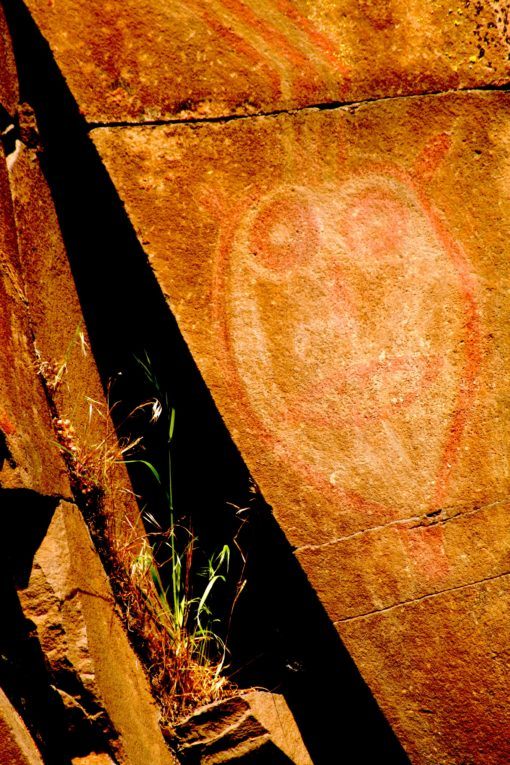
Salmon Shaman rock painting (Yakima polychrome style) on a basalt ledge overlooking Columbia River near Memaloose Island. Photo: Jeffrey St. Clair.
Here is a coyote tale I learned from Johnny Whizz, an old dipnet fisherman of the Yakima Tribe. Whizz told me the story a few years ago on a foggy morning as we motored in his skiff up the choppy Columbia River toward Memaloose Island, an ancient burial ground of the river tribes. It goes like this.
Coyote is walking on the beach contemplating a curious thing: the mighty Chinook River has run dry, its big delta now a stinky mudflat. Coyote sits down on a driftwood log, scratches his ear.
After a while, Coyote is startled from his reverie by a sharp whistle from the ocean. It’s Old Man Salmon, poking up from the surf. His face is flaking off.
“Hey, Coyote, come here.”
Coyote is wary. He’s never seen Old Man Salmon looking quite this bad. You can see his bones. He skulks closer to the fish, but keeps a safe distance.
“What’s the matter with your face, Salmon?”
“That’s I what I need to talk to you about, Coyote. You need to help us. The Frog People have built a dam across the river. No water flows. It is past time for us to spawn. That is why my skin is falling off. If we don’t get up the river soon, the Salmon People will die without children.”
Coyote ponders the situation. Typically, his mind is muddled. So he takes a dump.
“Hey, Coyote, what’s the problem?” It’s his turd talking.
“The Frog People have done a bad thing, Coyote Turd. They have built a dam across the river. They are hoarding all the water and keeping the Salmon People out.”

Native salmon fishing site at Dalles Dam. Photo: Jeffrey St. Clair.
The Turd commands Coyote to bend down. Coyote lowers his furry ear next to the Turd.
“So, here’s what you do, Coyote … ”
Coyote digs in the sand and uncovers some old bones of a sea lion. He takes one of the rib bones, chews it awhile and spit polishes it so that the shard resembles a dentalia shell, highly prized by the Frog People.
Coyote takes the bone and runs, his tail flat out, across the Coast Range, through the mossy rainforest, to a large dam made of earth and downed trees. Through the fog, Coyote sees a green lake behind it.
Coyote is panting when he meets the Frog People. He holds out his home-made gift.
“Hello, I’m very thirsty. I’ll give you this shiny shell, if you let me drink.
Old Man Frog takes the object from Coyote and holds it before his face like a mirror. Coyote doesn’t wait for an answer. He dives into the lake and begins lapping up the water in giant gulps.
“Don’t worry about me, this might take awhile. I’m parched.”
Coyote drinks and drinks and drinks and the lake begins to lower. Soon he has consumed half the water.
“Hey Coyote,” yells Old Man Frog. “If you keep drinking like that, you’ll owe us another shell!”
Then Coyote submerges beneath the water. Coyote is down there for a long time, digging furiously at the base of the dam until finally it breaches and the water cascades down the canyon.
“The river is for all the people, Old Man Frog. It needs to run free.”
Coyote is so full of water he looks like an engorged tick. He races to a hole in the ground near the top of a mountain, lifts his leg and pisses a mighty stream of water that soon fills the hole.
“Frog People, this is your pond. It is not a big pond, but it is yours.”
Then Coyote hops on a cedar log floating down the river and rides it all the way to the ocean. That night the Salmon People treat Coyote to a great feast. He eats and eats until he falls asleep with his ass plugging the entrance to Badger’s den. Badger gets irate at the intrusion and steals Coyote’s anus in revenge. Now Coyote will never again be able to seek advice from his turd and his mind will forever be muddled with too many conflicting ideas.
One way or another, Coyote always fucks up.
For more on Native American Coyote tales check out these books:
George W. Aguilar, When the River Ran Wild: Indian Traditions on the Mid-Columbia and the Warm Springs Reservation. University of Wasington Press. 2005.
Dell Hymes, “I Tried in Vain to Warn You”: Essays in Native American Ethnopoetics. University of Nebraska Press, 2004.
Barry Lopez, Giving Birth to Thunder, Sleeping with His Daughter: Coyote Builds North America. Harper, 1990.
Gary Snyder, The Old Ways, City Lights Books, 1977.
Sound Grammar
What I’m listening to this week…
Jon Batiste